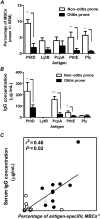Reduced serum IgG responses to pneumococcal antigens in otitis-prone children may be due to poor memory B-cell generation
- PMID: 22383675
- PMCID: PMC3308907
- DOI: 10.1093/infdis/jis179
Reduced serum IgG responses to pneumococcal antigens in otitis-prone children may be due to poor memory B-cell generation
Abstract
A low level of serum antibody to antigens expressed by Streptococcus pneumoniae has been proposed to explain the susceptibility of children to recurrent episodes of acute otitis media (hereafter, "otitis-prone children"). By use of enzyme-linked immunospot assays, the percentages of memory B cells to pneumococcal protein antigens PhtD, LytB, PcpA, PhtE, and Ply were compared between otitis-prone and non-otitis-prone children at the time of acute otitis media or nasopharyngeal colonization with S. pneumoniae. We found significantly lower percentages of memory B cells to 3 pneumococcal protein antigens (PhtD, PhtE, and Ply) and reduced antigen-specific immunoglobulin G concentrations in otitis-prone children, compared with non-otitis-prone children.
Figures

Similar articles
-
Synchrony in serum antibody response to conserved proteins of Streptococcus pneumoniae in young children.Hum Vaccin Immunother. 2015;11(2):489-97. doi: 10.4161/21645515.2014.990861. Hum Vaccin Immunother. 2015. PMID: 25692218 Free PMC article.
-
Serum antibody response to five Streptococcus pneumoniae proteins during acute otitis media in otitis-prone and non-otitis-prone children.Pediatr Infect Dis J. 2011 Aug;30(8):645-50. doi: 10.1097/INF.0b013e31821c2d8b. Pediatr Infect Dis J. 2011. PMID: 21487325 Free PMC article.
-
Modeling specific antibody responses to natural immunization to predict a correlate of protection against infection before commencing a clinical vaccine trial.Hum Vaccin Immunother. 2017 Oct 3;13(10):2316-2321. doi: 10.1080/21645515.2017.1329064. Hum Vaccin Immunother. 2017. PMID: 28892455 Free PMC article.
-
Clinical bacteriology and immunology in acute otitis media in children.J Infect Chemother. 2008 Jun;14(3):180-7. doi: 10.1007/s10156-007-0599-3. Epub 2008 Jun 24. J Infect Chemother. 2008. PMID: 18574652 Review.
-
Acute otitis media in the era of effective pneumococcal conjugate vaccine: will new pathogens emerge?Vaccine. 2000 Dec 8;19 Suppl 1:S96-9. doi: 10.1016/s0264-410x(00)00286-3. Vaccine. 2000. PMID: 11163471 Review.
Cited by
-
Comparison of pneumococcal conjugate vaccine (PCV-13) cellular immune responses after primary and booster doses of vaccine.Hum Vaccin Immunother. 2020 Dec 1;16(12):3201-3207. doi: 10.1080/21645515.2020.1753438. Epub 2020 May 13. Hum Vaccin Immunother. 2020. PMID: 32401658 Free PMC article.
-
Subversion of host immune responses by otopathogens during otitis media.J Leukoc Biol. 2019 Oct;106(4):943-956. doi: 10.1002/JLB.4RU0119-003R. Epub 2019 May 10. J Leukoc Biol. 2019. PMID: 31075181 Free PMC article. Review.
-
Nasopharyngeal bacterial interactions in children.Emerg Infect Dis. 2012 Nov;18(11):1738-45. doi: 10.3201/eid1811.111904. Emerg Infect Dis. 2012. PMID: 23092680 Free PMC article.
-
Reducing the frequency of acute otitis media by individualized care.Pediatr Infect Dis J. 2013 May;32(5):473-8. doi: 10.1097/INF.0b013e3182862b57. Pediatr Infect Dis J. 2013. PMID: 23340550 Free PMC article.
-
Ten-Year Study of the Stringently Defined Otitis-prone Child in Rochester, NY.Pediatr Infect Dis J. 2016 Sep;35(9):1033-9. doi: 10.1097/INF.0000000000001217. Pediatr Infect Dis J. 2016. PMID: 27273691 Free PMC article. Review.
References
-
- Vergison A, Dagan R, Arguedas A, et al. Otitis media and its consequences: beyond the earache. Lancet Infect Dis. 2010;10:195–203. - PubMed
-
- Poehling KA, Szilagyi PG, Grijalva CG, et al. Reduction of frequent otitis media and pressure-equalizing tube insertions in children after introduction of pneumococcal conjugate vaccine. Pediatrics. 2007;119:707–15. - PubMed
-
- Zhang Q, Bagrade L, Bernatoniene J, et al. Low CD4 T cell immunity to pneumolysin is associated with nasopharyngeal carriage of pneumococci in children. J Infect Dis. 2007;195:1194–202. - PubMed
-
- Snapper CM, Shen Y, Khan AQ, et al. Distinct types of T-cell help for the induction of a humoral immune response to Streptococcus pneumoniae. Trends Immunol. 2001;22:308–11. - PubMed
Publication types
MeSH terms
Substances
Grants and funding
LinkOut - more resources
Full Text Sources
Other Literature Sources
Medical

